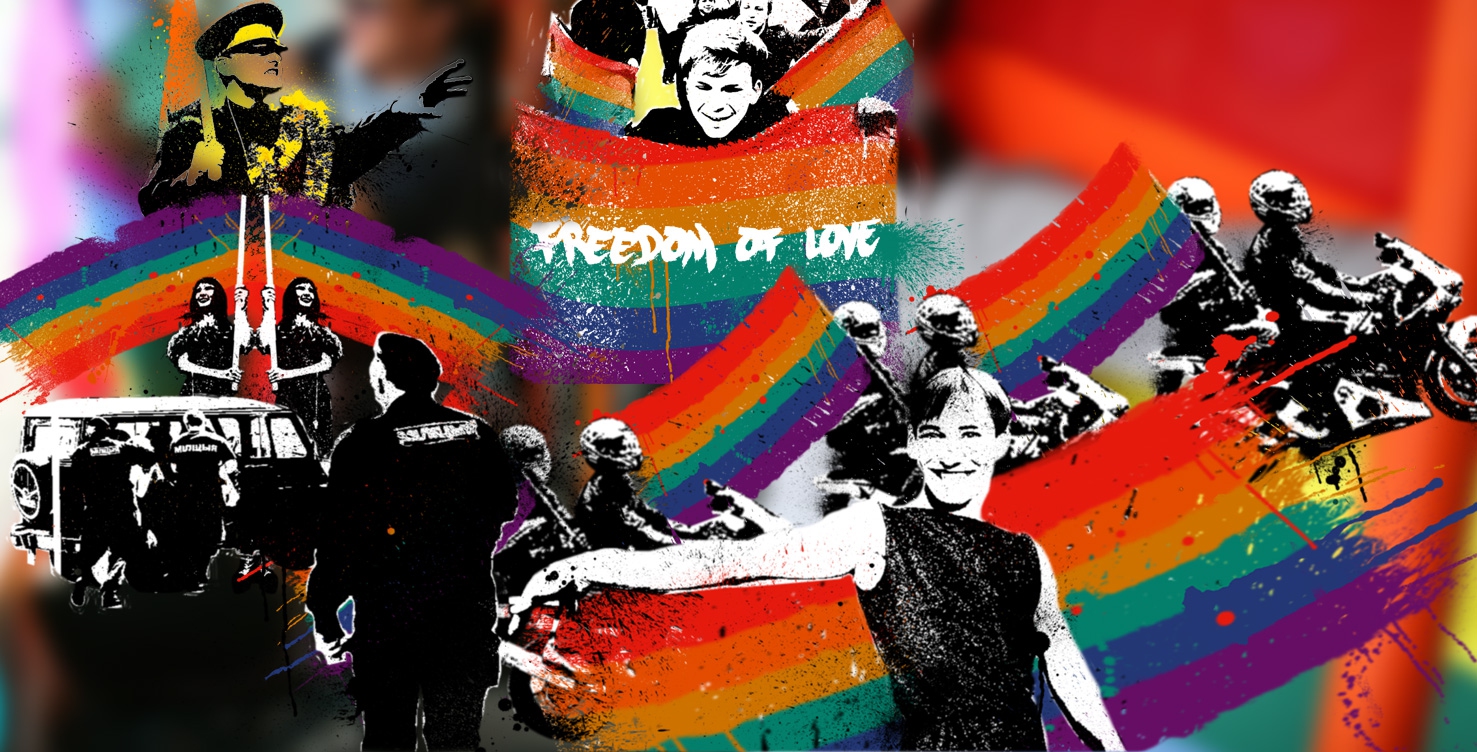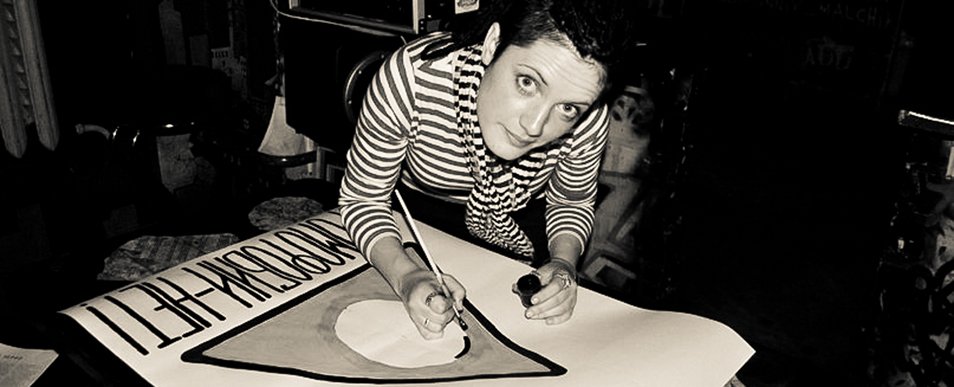Belarus is the first post-Soviet country to have organized a series of protests in support of LGBTQ human rights. This article will consider probably the most popular variety of such events: gay prides, human rights events that promote tolerance towards LGBTQ people.
The first pride festival in Belarus was held in Minsk in 1999. The program of the Belarus Gay Pride 1999 included seminars, exhibitions, and a conference, which were attended by around 500 people. Two years later, in 2001, the country’s first pride demonstration took place in the heart of Minsk with, according to various assessments, 500 to 2,000 participants.
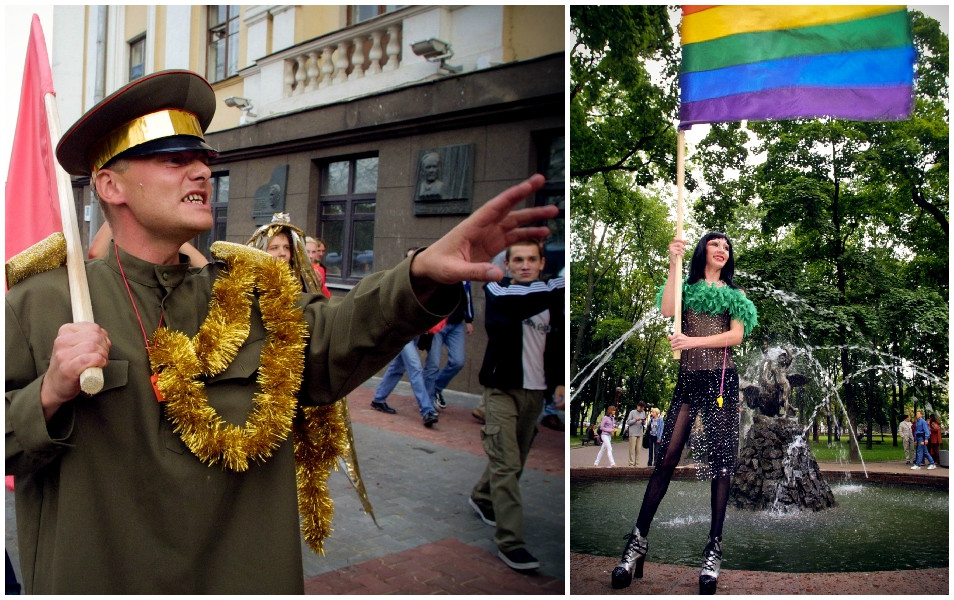
People dressed in brightly coloured party clothes and carrying rainbow flags walked down the Independence Avenue (then Skorina Avenue) from the Circus building to the Panikovsky pocket park on the October Square. Although the demonstration was not sanctioned by the authorities, it went down without serious incidents. The organizers themselves emphasized the event’s festive character and called it a “love parade”. Later on that day, a carnival travesty show was held with the headline We Choose Love.
Excerpt from an article: A LOVE PARADE. Before the Elections.
(Belgazeta No. 35, 2001)
“In the evening, youngsters began to gather near the circus. Very diverse youngsters at that. Two young men (“We’re from Angarskaya,” they said) were passing by and decided to make a stop. The boys from Angarskaya street had heard that love parades were held in many European capitals and, although they liked women, they decided to join. Two more young men wearing suits and ties commented that “they” were in no way different from “us”, so “why shouldn’t we come together?” “There are too few celebrations in our country,” leaders of the Belarus Anarchists Federation said. “We must organize them ourselves. Our motto is: Every day is a holiday!” To earsplitting noise produced by the whistles distributed to the participants and drum beats, a multicoloured banner was unfolded. After that, the several hundreds of people proceeded down the Avenue. Obviously, the spectacle was eye-catching, bright and festive, as it made passersby stop in their tracks, smile at the happy young people and even join in. The crowd made its way along the Avenue without any incidents and turned into the pocket park near the Yanka Kupala Theater. That was when militia officers with radio phones appeared. “What are they doing? Well, what can they be doing?” one frustrated officer was saying into his radio. “Dancing!” (…) The goal has been achieved, the love parade has taken place. Blue and pink, white and black youth have marched down the Avenue, declaring their right to love regardless of colour, time, or political power.”
It is hard to believe today that it has ever been possible to organize an event in Minsk that looked more like a carnival demonstration than a human rights manifestation held under homophobic pressure (as were all the subsequent attempts at gay prides in Minsk). In other words, this first and certainly exciting experience turned out to be an exception.
As soon as the next year, the third Belarusian pride festival organizer Edward Tarletsky focuses on the political aspect of the event. The 2002 festival takes place under the following slogan: “You Shall Make For Yourself An Other”. Unlike the previous year, the program does not include a pride march through Minsk streets, and in a media interview, Edward Tarletsky states his intention “to make Belarusian gays and lesbians more politicized”:
“We’ve noticed from last year’s experience that the press are most interested in the transsexuals who walk in the first row, but that’s not at all what you should focus on. There is an idea: we need to unite the country’s gay and lesbian groups to hold a street protest with political demands. We suggest the society considers a person who is different from others not as an enemy, but as its full-fledged member. Our ultimate goal is to make life freer and safer for lesbians, gays and bisexuals in Belarus.”/
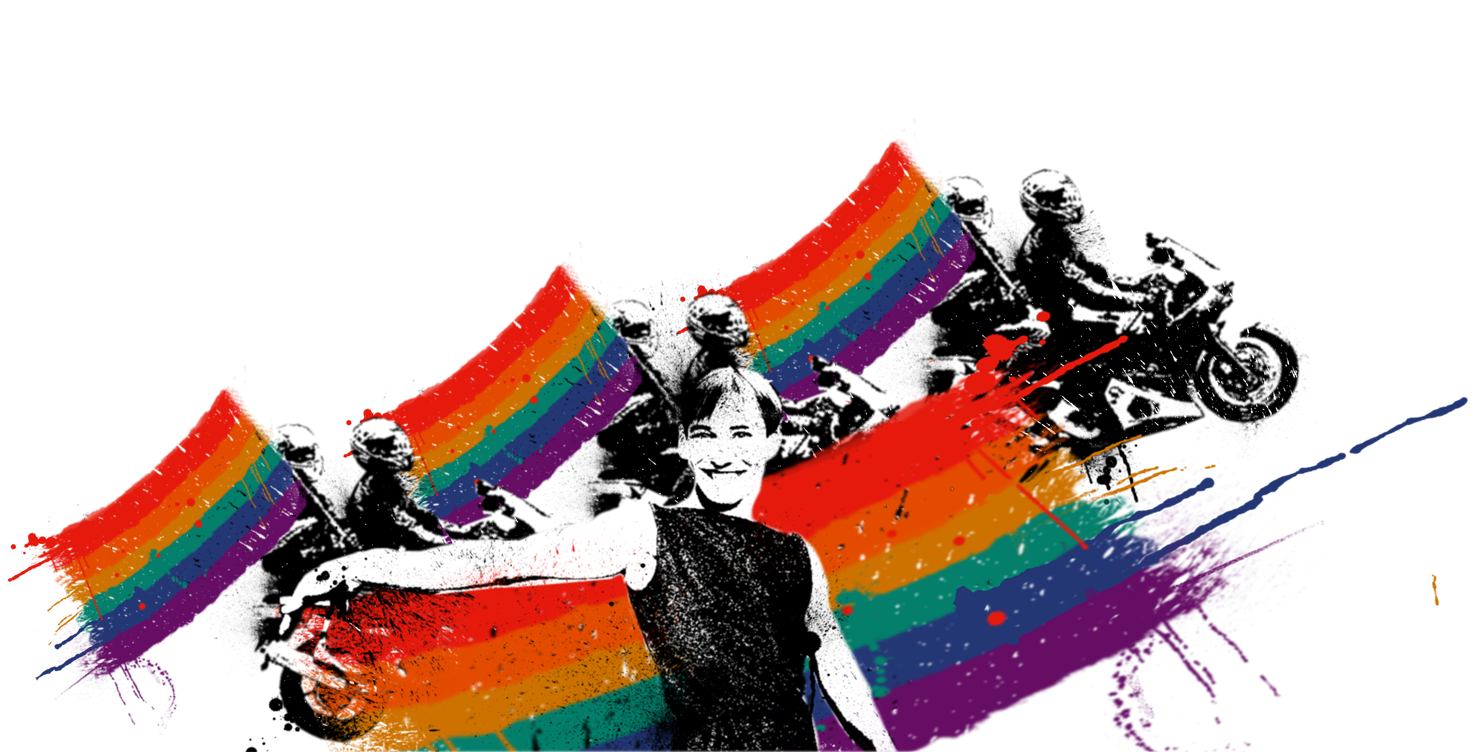
Pride ≠ Parade
As the conditions for LGBTQ activism in the Belarusian context are different from those in Western Europe, a gay pride here is not a gala carnival procession but a human rights event that promotes tolerance towards LGBTQ people and is rooted in the idea of respect for human rights.
It is obvious that the word parade does not fit this content. It is no entertainment, there is almost nothing celebratory about the events. Whereas pride participants in Western Europe dance in the streets, the main focus in Belarus is on protection against homophobes, and when the prides are banned, from the police as well.
Of the 13 years of pride organizing in our country, an official authorization to hold an anti-homophobic picketing was issued only once, in 2011.
All the other requests to hold assemblies, marches, picket lines or other events in Minsk and the regions were denied. Preparation for the pride usually takes place in strictest secrecy.
If we consider holding a pride as an attempt to convey a certain message, can it be efficient in Belarus?
In many countries, gay prides induce social and political conflicts. In 2009 in Belgrade, members of far right organizations engaged into mass riots during the gay pride. In Russia where the state is waging a war against “propaganda of homosexualism”, the LGBTQ community is effectively prevented from organizing legal demonstrations.
The situation is similar in Belarus: considering the pride to be a “Western threat” is popular here, and the LGBTQ community is accused of publicly “flaunting their vices”. In other words, LGBTQ activism is not perceived as a manifestation of the crucial process of society’s emancipation from previous restrictions, but rather as a sign of degradation and decadence.
Another peculiarity of the Belarusian context is that LGBTQ “parades” (along with the need for according legal protection) raise protests among the opposition as well. At best, those issues are simply missing from the opposition parties’ agendas, at worst they are met with overt hostility. Furthermore, the same is also true of human rights defenders.
***
Let us go back to the gay pride organizing history in Belarus. In 2000, during Belarus Gay Pride 2000, the second pride festival, which was held under the slogan of Equality For All, most events in the program, including the pride march, were either disrupted or banned. The festival’s opening in the Aquarium club was interrupted: the lights went off in the middle of the event and the people were taken outside.
Excerpt from an article: TURNING OFF THE LIGHT. At First, Only For Gays
(Belgazeta, No. 35, 2000)
“It’s so easy: you only have to push the master switch, and the strange, odd party will cease, the wrong songs will die away. Today we turn off the lights on the independent press festival, which the Vitebsk authorities have banned without giving any reasons, tomorrow we kick out the gays. The less light the better—after all, you can do anything you want in the dark, unchallenged and unpunished. A darkness has descended on the country—at first, only for the gays. Tomorrow they will turn off the light for someone else. All it takes is to push the master switch.”
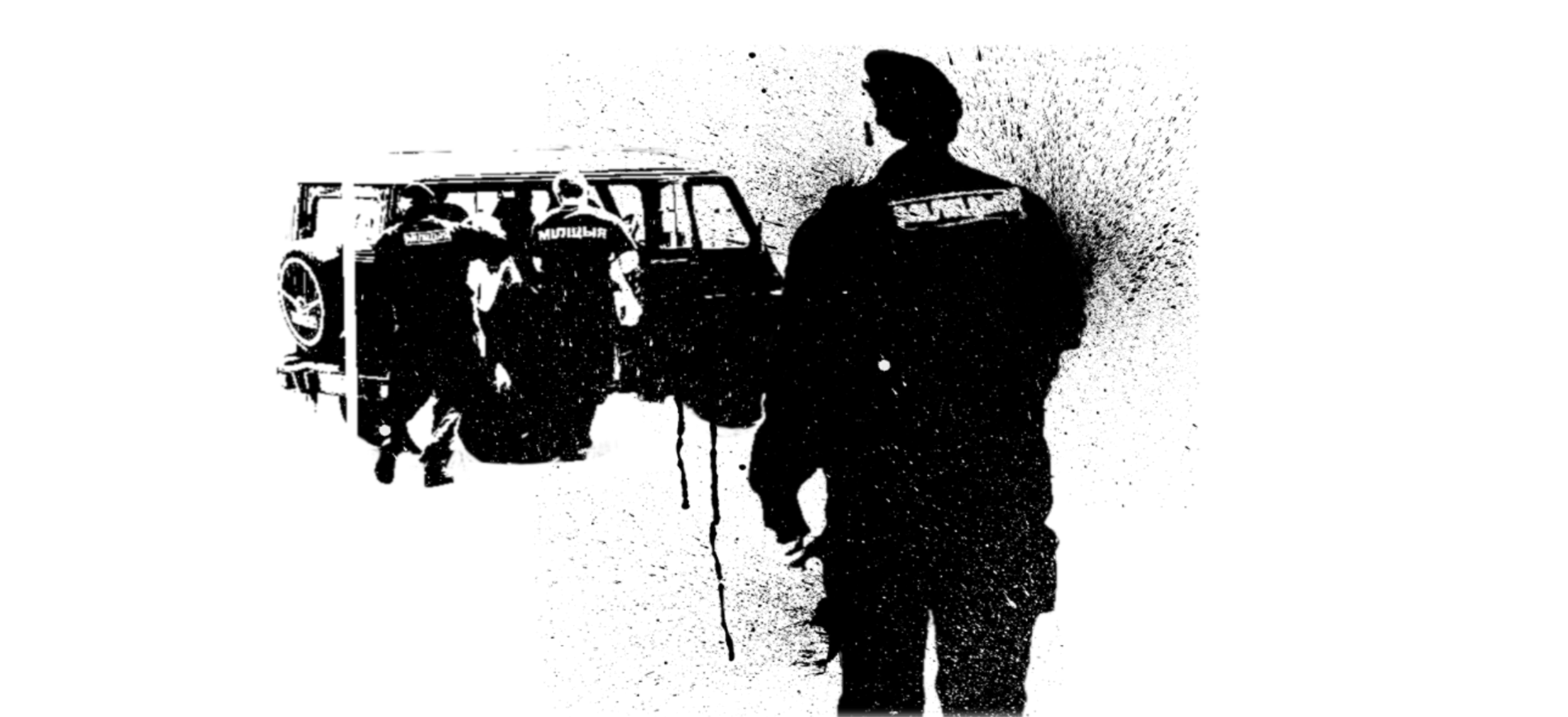
The Minsk Gay Pride 2008
After a six-year-long pause, an event first took place in Minsk that its organizers called a gay pride. It was a single occurrence. On October, 11, 2008, LGBTQ activists held a demonstration under the following slogan: To Know How To Be! To Know How To Love! To Know How To Be Proud! Around 30 people walked on the sidewalk down from Yakub Kolas Square, carrying rainbow flags. The demonstration ended, as in 2001, in the Panikovsky pocket park on October Square. It had lasted for about an hour. There were no problems with the police or homophobes, probably due to the total lack of advertising beforehand.

One of the march participants compared it to a meticulously planned show, “an ideal model of a gay pride”:
“Chances are, the real pride, which awaits us somewhere in the future, won’t be that well planned, people won’t march in that perfectly organized fashion, and the pride will lead to a lot of surprises, whether nice ones or not, but real ones anyway. We hope that the amazing show that was scripted and staged by Syarhey Androsenka on October, 11, 2008, will someday turn into real, chaotic life.”
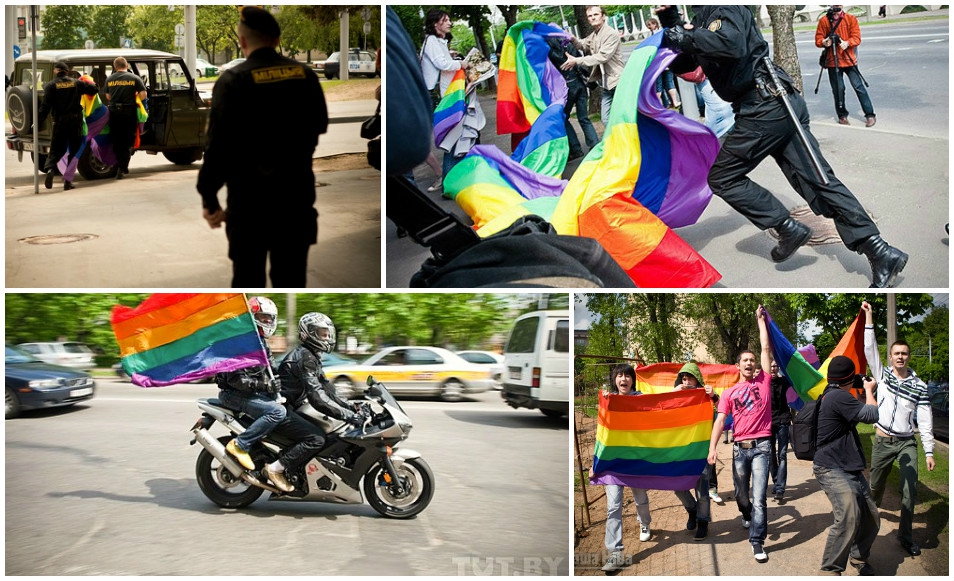
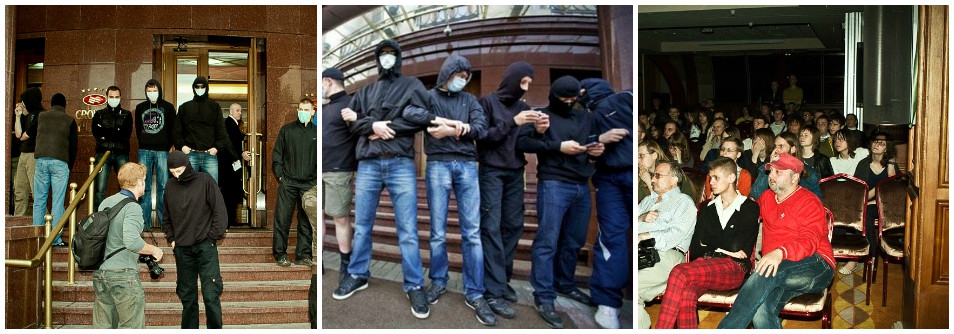
The Slavic Gay Pride 2010
Despite yet another ban, the Slavic Gay Pride 2010 march was held in Minsk on May, 15, 2010, by around 30 participants from Russia and Belarus. The marchers were carrying a 12-meter-long flag. They walked about 400 meters down Surganov street, stopped, unfolded flags, and chanted: “Homophobia Is a Disease!” “Gay Rights Straight Out!” “Belarus Without Homophobia!” After a short rally, the demonstration participants walked about 150 more meters, whereat they were driven away violently by special operations forces who took away the flag and beat up several of the marchers. Furthermore, several people were detained.
The event was not open to all, it had been announced through private channels, and as a result, the only people apart from LGBTQ rights activists who knew where it was going to take place were the press (the march was covered by around 30 journalists). An incident during the demonstration was caused by a BelaPAN journalist Vasiliy Semashko who, using his privileges as a member of the press, brought a dozen eggs to the march to protest against the gay pride and its participants.
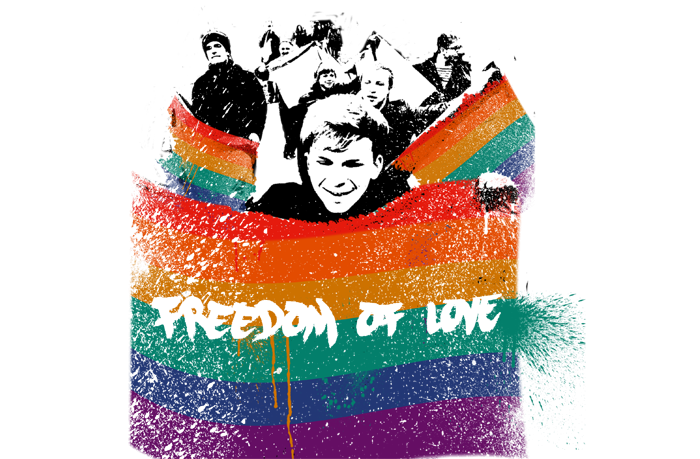
The Gay Pride In Shabany
In 2011, the next gay pride was held on the outskirts of Minsk, in the Shabany neighbourhood. Fifteen people participated in the march; they walked 200 meters down Silitsky street, carrying rainbow flags and chanting: “Gay Is Normal! It’s Normal To Be Gay! Pride Is Normal!” The demonstration lasted for about ten minutes. After the march, the activists launched a 20-meter-long rainbow flag into the sky.
The demonstration was initially supposed to take place in the Sosny district, but although the announced route ran far away from the city center in a deserted area, the city authorities considered it necessary to ban the LGBTQ community’s public gathering, referring to the close proximity of “objects of the population’s daily living activities” and possible “obstruction of pedestrian and vehicle traffic”. Interestingly, the President had spoken on the subject not long before that, stating that he wouldn’t ban the march (“I wouldn’t ban it if it’s somewhere on the outskirts of the city, why not let people have some fun watching, let the people see”).
“The city authorities banned the peaceful gay pride demonstration in Sosny. Then we decided to hold it a little closer to Minsk. We’re not planning anything bad. We want to walk in a march on the outskirts of the city, just as we wanted to do it in Sosny. Simply because we are not ashamed of ourselves and we want equal rights. The gays will walk 50, 100 meters, or 200 meters across the city, that won’t hurt anybody. No one will die.”
Sergey Androsenko, Minsk Gay Pride 2011 organizer
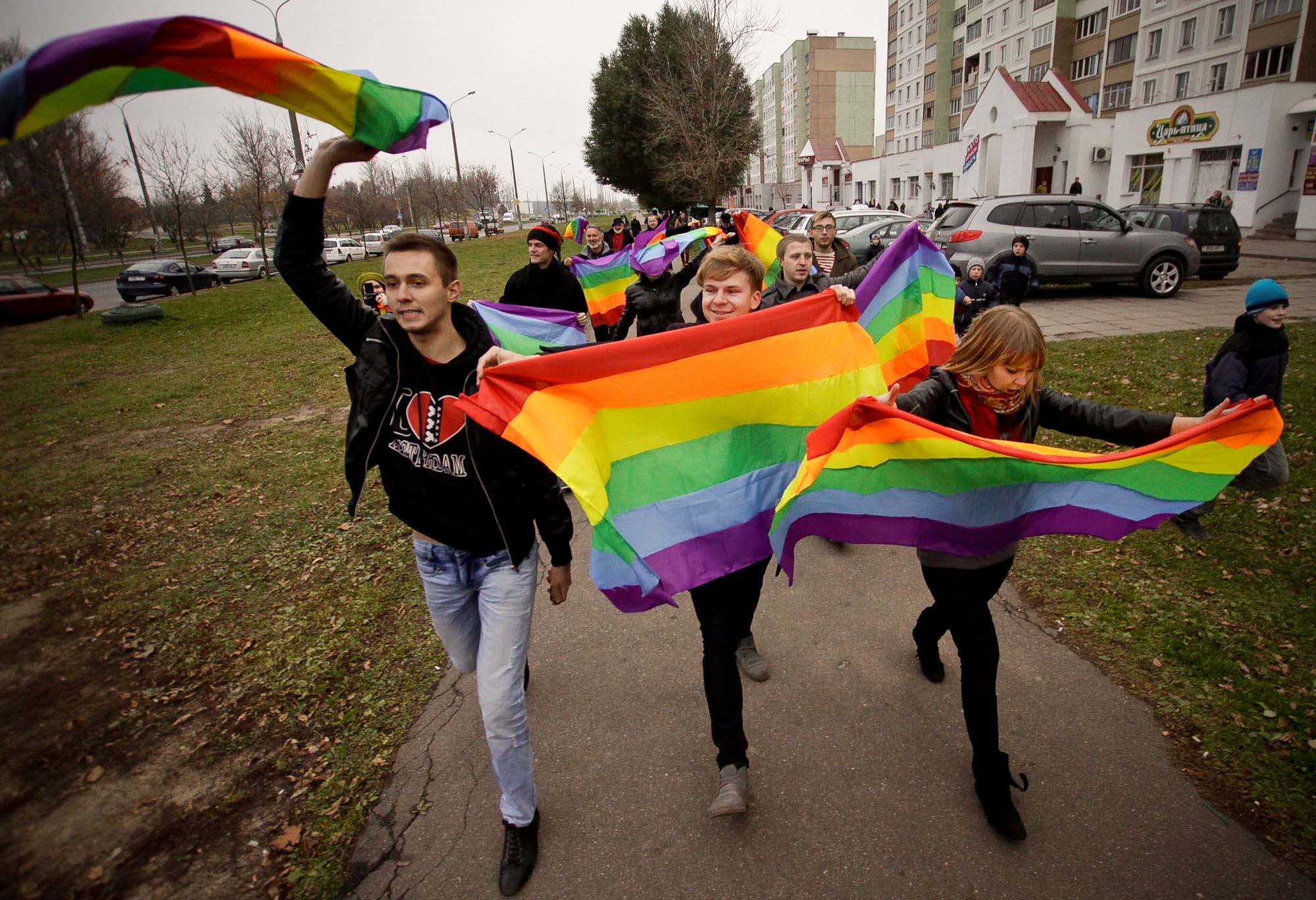
Just as with the previous gay pride events, the preparations for the march went down in strictest secrecy for security reasons. The organizers did not disclose the demonstration’s venue until the very last moment, and the participants took different routes to arrive. Journalists, too, had to put in great efforts to be allowed to attend the event. To keep the venue secret until the right moment, the organizers made a tour in a taxi and picked up journalists across the whole city. It was virtually impossible to express one’s views and participate in the event if you were not a journalist or an activist.
The Pride Tram
Finally, the last public act entitled “pride” took place in 2012. Geographically it covered more city land than any other pride in Minsk. However, there was no direct interaction between the participants and the city space.
Around 15 activists of the Minsk Gay Pride 2012 drove across the city in a tram with banners, rainbow flags, and balloons. The event was not connected to a fixed location but stretched across almost the whole city (along the tram route, from the Zeleny Lug neighbourhood to the central railway station). With music, dancing, and slogans such as Love Is Not a Feeling That Should Be Hidden, LGBTQ activists drove through the whole city and back.
“The Minsk City Executive Committee has barred us from holding the parade in other forms and we see no other way to express ourselves. We want to give a little joy to the city. In fact, many people smiled and greeted us. I think many will remember it.”
Natalya Mankovskaya, Minsk Gay Pride 2012 organizer
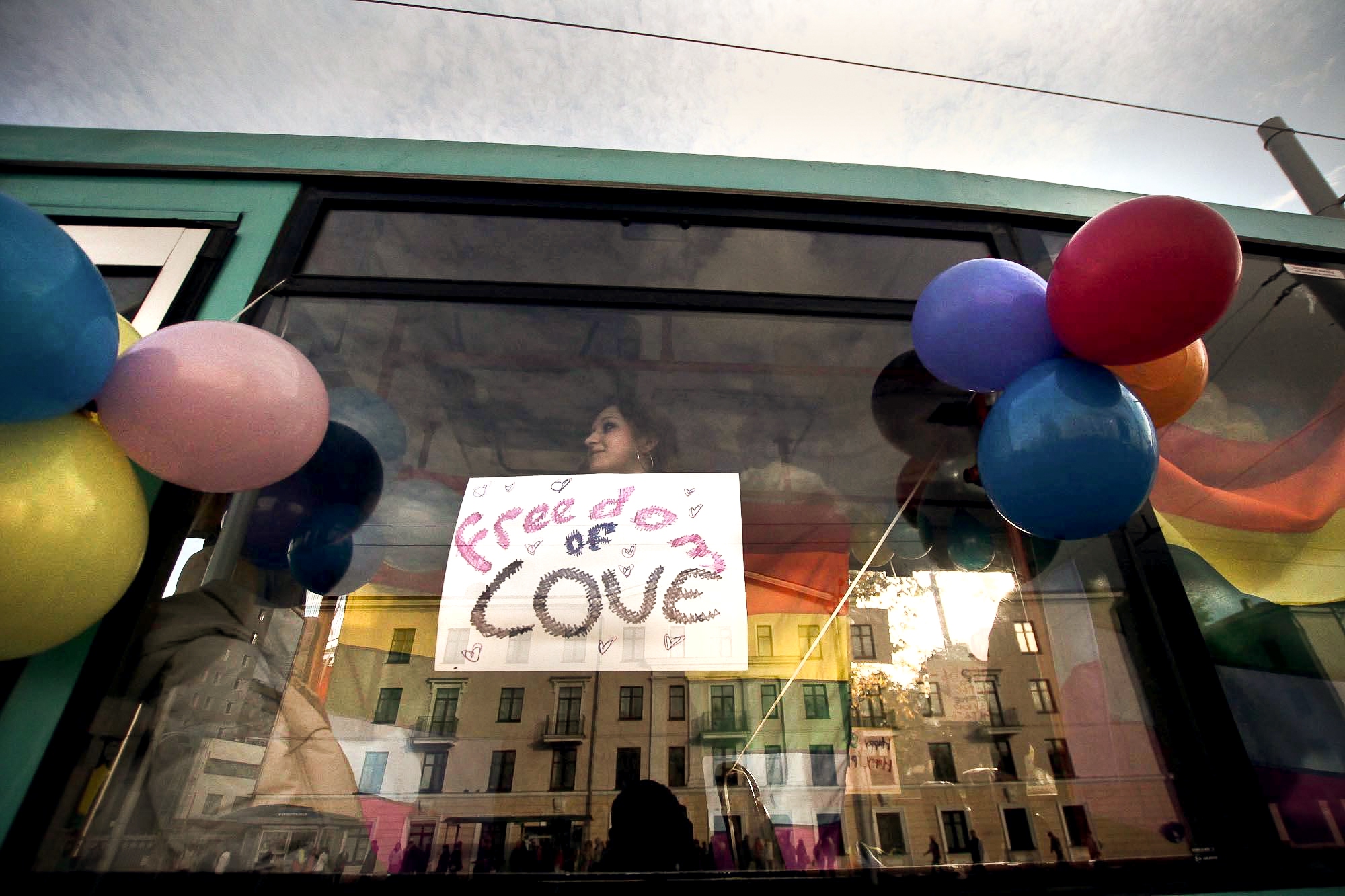
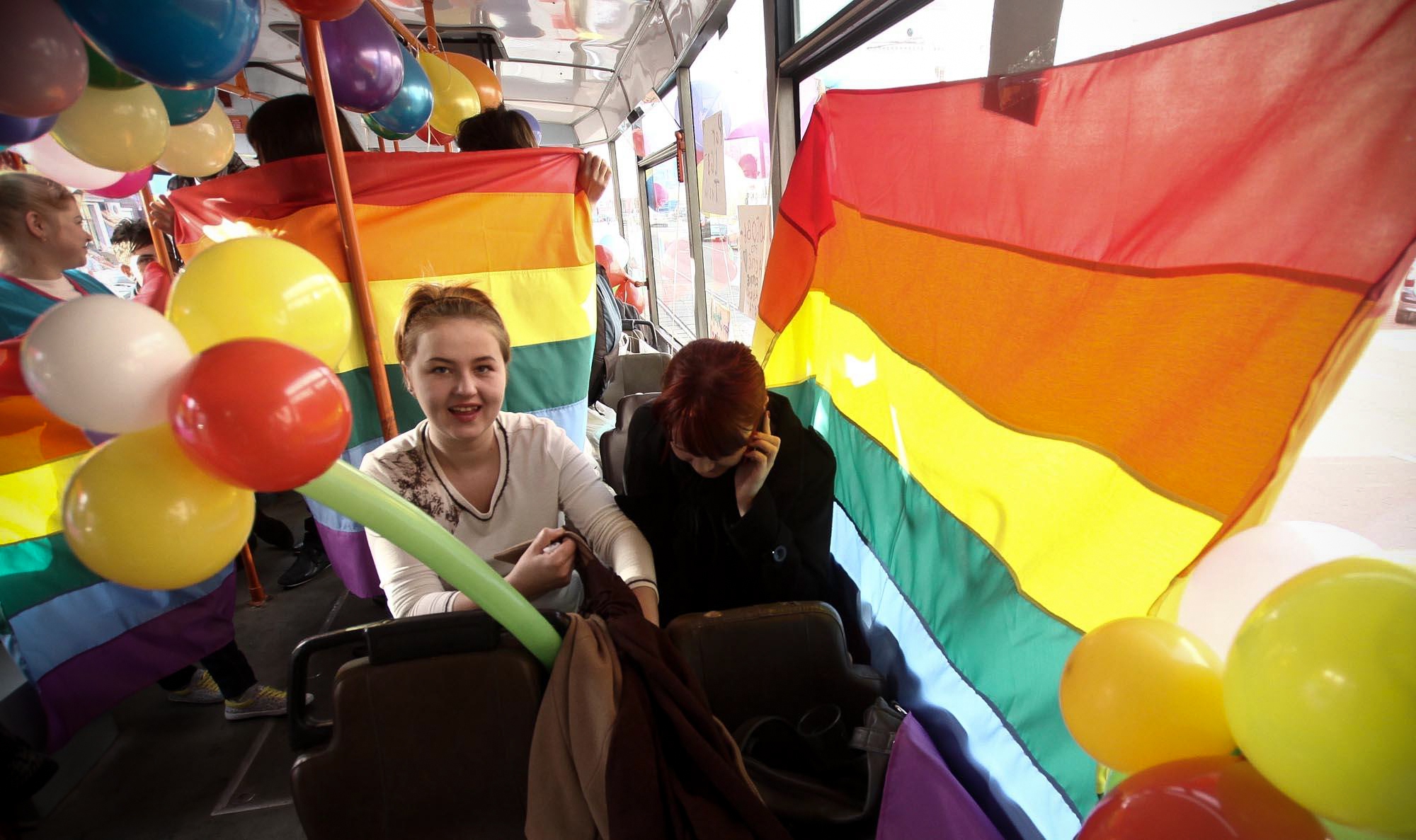
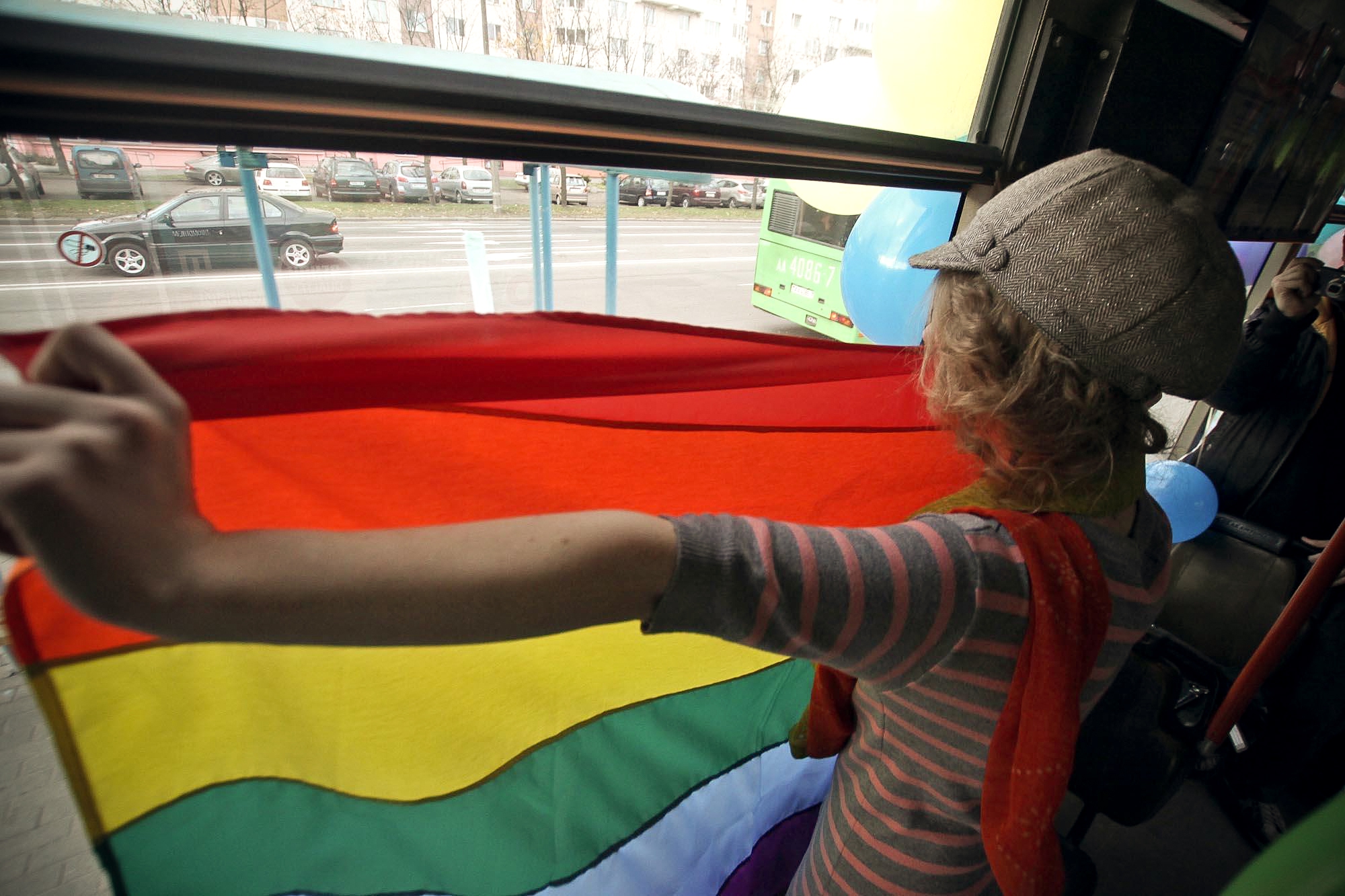
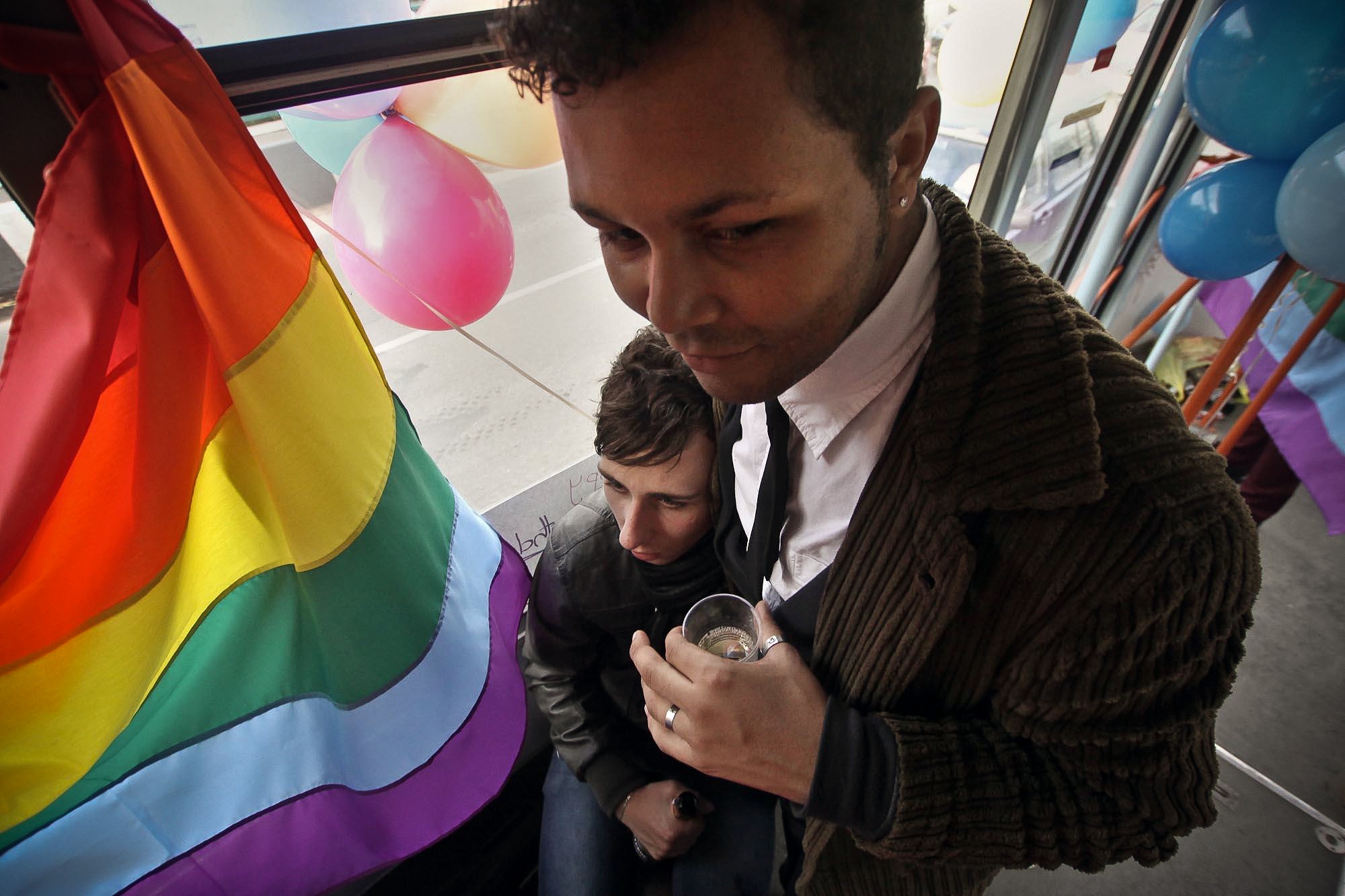
The next year, in 2013, activists decided to hold no pride march but to hang out a 5-meter-long rainbow flag on a bridge across the M1 highway to protest against the ban on public acts for LGBTQ rights. All other pride events that year were held under the slogan of We Exist!
***
To sum up the recent years’ experience, there are several typical features that have been more or less apparent in every pride event in Minsk. As already mentioned before, during the whole period since 1999, only one event to promote LGBTQ rights was allowed by the city authorities, and it was not a pride march. Public actions have generally happened spontaneously and been unexpected for the city. Often no one, apart from the participants and journalists (who received the information at the last moment) knew the time and place of the action or demonstration beforehand.
More than once, the outskirts of the city have served as the scene of action, and demonstrations have often lasted no more than ten minutes: they have started suddenly and wrapped up just as swiftly.
If, however, the demonstration or other action would take up a little more time and space, they would end with brutal detainments.
There have been attempts at using the city space in interesting and unusual ways (as in the case of the tram pride), but in my opinion, the experience has not been satisfactory. Moreover, it has demonstrated clearly the struggles LGBTQ activists face when trying to convey a certain message. It has also proved that there was a glitch in the “Source — Code — Recipient — Interpretation” chain. This event makes it apparent that the participants (located within the tram) are separated from the city space and its inhabitants (who are observing the developments from the outside through the tram windows). An interesting effect is produced by a video report made by a journalist who managed to film on both sides. When the camera is inside, we can hear music and singing, we “get” what is going on, we can even join in and start moving to the music, and we can also listen in to the participants talking to each other. But as soon as the camera is relocated outside, we stop hearing any sounds. All we can access is the picture with moving people, which makes the goings-on seem foolish and incomprehensible.
Gay prides remain marginal events that are not integrated in the city space. As a result, they cannot be inscribed in the common city calendar.
Having examined the Belarusian pride geography and forms, one may conclude that gay prides remain marginal events that are not integrated in the city space. As a result, they cannot be inscribed in the common city calendar, as private information channels are used deliberately to disseminate information about the demonstrations or actions, which ultimately prevents city residents from perceiving them as community events.
If we consider the pride as an attempt to convey a certain message to the city residents, we must conclude that the lack of open dissemination channels leads to misinterpretation. Most of the residents have no instruments to read this particular cultural code, hence no means to receive the information: it reaches them only as noise (depending on how the press covers it). Because the message cannot be received, it cannot be answered adequately. When we speak of a glitch in the “Source — Code — Recipient — Interpretation” chain, we understand the city space as a kind of a medium, a mass communication tool people may use to send and receive messages (with or without distortion). The media are controlled by the government through the police. In that case, can it be that a pride march is actually not the best tactic in our conditions? Can the state control be bypassed? The tram pride seems to have been an attempt at that, but can we think of other options, of more efficient political strategies? Or is a pride, for now, the only way to get through to the society?

